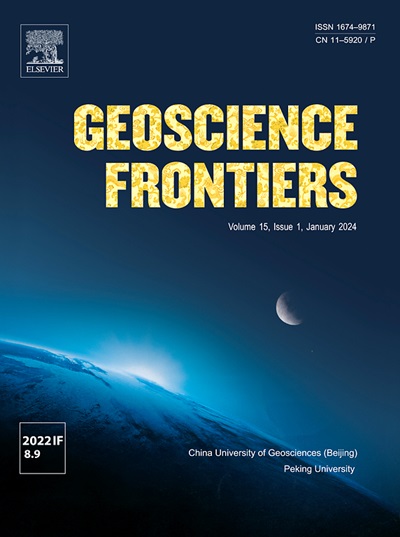小红石砬子铅锌(银)矿床锌、镉同位素特征:矿床成因及找矿对策
IF 8.9
1区 地球科学
Q1 GEOSCIENCES, MULTIDISCIPLINARY
引用次数: 0
摘要
冀中-延边铜、钼、金、铅锌多金属成矿带是东北地区重要的有色金属和贵金属资源基地。这个地区的矿床成因一直存在争议。为了约束矿石成因模型,为勘探提供信息,我们对闪锌矿和方铅矿进行了精确的锌镉同位素测量。方铅矿和闪锌矿的δ66ZnAA-ETH值分别为- 0.07‰~ 0.03‰和- 0.68‰~ - 0.12‰;δ114/110CdNIST SRM 3108值变化范围分别为- 0.96‰~ 3.83‰和- 0.63‰~ 0.77‰。研究认为,小红石砬子铅锌银矿床的地质特征、硫化物微量元素特征、S-Pb-Fe-Zn-Cd同位素特征均与典型的MVT矿床相似,只是围岩存在差异,属于密西西比河谷型矿床。闪锌矿沉淀过程中的瑞利分馏被确定为Zn-Cd同位素变化的主要机制,并通过100°C至250°C的Zn-Cd分馏模型验证了这一点。最后,提出了基于成矿流体运移路径的找矿模型和100℃下闪锌矿锌同位素分选模型。该模型显示了东、西矿区当前开采水平的浅/外围和深部未发现的潜在资源,部分潜在资源已通过近期钻探得到证实。尽管成矿过程复杂,但本研究为在类似背景下应用锌镉同位素了解矿床成因和指导找矿提供了新的见解。本文章由计算机程序翻译,如有差异,请以英文原文为准。

Zinc and cadmium isotope signatures: Insights into ore genesis and exploration strategies at the Xiaohongshilazi Pb-Zn-(Ag) deposit, Northeast China
The Jizhong–Yanbian Cu-Mo-Au-Pb-Zn polymetallic metallogenic belt is a major nonferrous and precious metal resource base in Northeastern China. The genesis of ore deposits in this district has remained controversial. To constrain ore genetic models and provide information for exploration, we conducted precise Zn-Cd isotopic measurements on sphalerite and galena. The δ66ZnAA–ETH values of galena and sphalerite range from −0.07‰ to 0.03‰ and −0.68‰ to −0.12‰, respectively; and their δ114/110CdNIST SRM 3108 values vary from −0.96‰ to 3.83‰ and −0.63‰ to 0.77‰, respectively. Our study suggests that the Xiaohongshilazi Pb-Zn-(Ag) deposit should be classified as a Mississippi Valley Type (MVT)-like deposit, because both its geological, sulfide trace elemental, and S-Pb-Fe-Zn-Cd isotopic characteristics are similar to those of the typical MVT deposit, except for the differences of the wall rocks. Rayleigh fractionation during sphalerite precipitation is identified as the primary mechanism for Zn-Cd isotopic variations, which is validated by the Zn-Cd fractionation models from 100 °C to 250 °C. Finally, we propose an ore prospecting model based on migration pathways of ore-forming fluid and the Zn isotopic fractionation model of sphalerite under 100 °C. This model indicates potential resources undiscovered at shallow/peripheral and deep zones of current mining level in both the Eastern and Western Ore Block, with parts of the potential resources having been corroborated by recent drilling. Despite the complexity of mineralization, processes, this study provides new insights into the application of Zn-Cd isotopes in understanding ore genesis and guiding mineral exploration in similar contexts.
求助全文
通过发布文献求助,成功后即可免费获取论文全文。
去求助
来源期刊

Geoscience frontiers
Earth and Planetary Sciences-General Earth and Planetary Sciences
CiteScore
17.80
自引率
3.40%
发文量
147
审稿时长
35 days
期刊介绍:
Geoscience Frontiers (GSF) is the Journal of China University of Geosciences (Beijing) and Peking University. It publishes peer-reviewed research articles and reviews in interdisciplinary fields of Earth and Planetary Sciences. GSF covers various research areas including petrology and geochemistry, lithospheric architecture and mantle dynamics, global tectonics, economic geology and fuel exploration, geophysics, stratigraphy and paleontology, environmental and engineering geology, astrogeology, and the nexus of resources-energy-emissions-climate under Sustainable Development Goals. The journal aims to bridge innovative, provocative, and challenging concepts and models in these fields, providing insights on correlations and evolution.
 求助内容:
求助内容: 应助结果提醒方式:
应助结果提醒方式:


